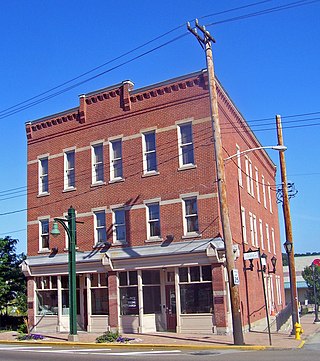Related Research Articles

Homestead is a borough in Allegheny County, Pennsylvania. The borough is located in the Monongahela River valley 7 miles (11 km) southeast of downtown Pittsburgh and directly across the river from the city limits. The borough is known for the Homestead Strike of 1892, an important event in the history of labor relations in the United States. The population of Homestead was 2,884 at the 2020 census.

The history of Pittsburgh began with centuries of Native American civilization in the modern Pittsburgh region, known as "Dionde:gâ'" in the Seneca language. Eventually, European explorers encountered the strategic confluence where the Allegheny and Monongahela Rivers meet to form the Ohio, which leads to the Mississippi River. The area became a battleground when France and Great Britain fought for control in the 1750s. When the British were victorious, the French ceded control of territories east of the Mississippi.

Roy Emerson Stryker was an American economist, government official, and photographer. He headed the Information Division of the Farm Security Administration (FSA) during the Great Depression, and launched the documentary photography program of the FSA. It hired photographers to travel across the United States and document people in different areas and settings as part of showing the state of people in rural areas in those years. Specific projects were conceived to help assess effects of government programs.

The Farm Security Administration (FSA) was a New Deal agency created in 1937 to combat rural poverty during the Great Depression in the United States. It succeeded the Resettlement Administration (1935–1937).

North Side refers to the region of Pittsburgh, Pennsylvania, located to the north of the Allegheny River and the Ohio River. The term "North Side" does not refer to a specific neighborhood, but rather to a disparate collection of contiguous neighborhoods.

The Carnegie Library of Pittsburgh is the public library system in Pittsburgh, Pennsylvania. Its main branch is located in the Oakland neighborhood of Pittsburgh, and it has 19 branch locations throughout the city. Like hundreds of other Carnegie libraries, the construction of the main library, which opened in 1895, and several neighborhood branches, was funded by industrialist Andrew Carnegie. The Pittsburgh area houses the first branches in the United States.

Elliott Erwitt is a French-born American advertising and documentary photographer known for his black and white candid photos of ironic and absurd situations within everyday settings. He has been a member of Magnum Photos since 1953.
The Carnegie International is a North American exhibition of contemporary art from around the globe. It was first organized at the behest of industrialist and philanthropist Andrew Carnegie on November 5, 1896 in Pittsburgh. Carnegie established the International to educate and inspire the public as well as to promote international cooperation and understanding. He intended the International to provide a periodic sample of contemporary art from which Pittsburgh's Carnegie Museum of Art could enrich its permanent collection.

The Allegheny Observatory is an American astronomical research institution, a part of the Department of Physics and Astronomy at the University of Pittsburgh. The facility is listed on the National Register of Historic Places and is designated as a Pennsylvania state and Pittsburgh History and Landmarks Foundation historic landmark.

Lawrenceville is one of the largest neighborhood areas in Pittsburgh in the U.S. state of Pennsylvania. It is located northeast of downtown, and like many of the city's riverfront neighborhoods, it has an industrial past. The city considers Lawrenceville three neighborhoods, Upper Lawrenceville, Central Lawrenceville, and Lower Lawrenceville, but these distinctions have little practical effect. Accordingly, Lawrenceville is almost universally treated as being a single large neighborhood.

Esther Bubley was an American photographer who specialized in expressive photos of ordinary people in everyday lives. She worked for several agencies of the American government and her work also featured in several news and photographic magazines.
The Culture of Pittsburgh stems from the city's long history as a center for cultural philanthropy, as well as its rich ethnic traditions. In the 19th and 20th centuries, wealthy businessmen such as Andrew Carnegie, Henry J. Heinz, Henry Clay Frick, and nonprofit organizations such as the Carnegie Foundation donated millions of dollars to create educational and cultural institutions.

Forbes Avenue is one of the longest streets in Pittsburgh, Pennsylvania, United States. It runs along an east–west route for a length of approximately 7 mi (11 km).
Harold Corsini was an American photographer.
James P. Blair is an American photographer. His work has been published in National Geographic Magazine and elsewhere.
Richard Saunders (1922–1987) was a Bermudian photographer of the 20th century. He was noted for his photojournalism work with Roy Stryker, as well as in publications such as Ladies Home Journal, Fortune, Ebony and Look, among others.

The Carnegie Library of Homestead is a public library founded by Andrew Carnegie in 1898.
Steven W. Plattner is an American photographic historian, author, curator, and printing manager.

D-Scribe Digital Publishing is an open access electronic publishing program of the University Library System (ULS) of the University of Pittsburgh. It comprises over 100 thematic collections that together contain over 100,000 digital objects. This content, most of which is available through open access, includes both digitized versions of materials from the collections of the University of Pittsburgh and other local institutions as well as original 'born-electronic' content actively contributed by scholars worldwide. D-Scribe includes such items as photographs, maps, books, journal articles, dissertations, government documents, and technical reports, along with over 745 previously out-of-print titles published by the University of Pittsburgh Press. The digital publishing efforts of the University Library System began in 1998 and have won praise for their innovation from the leadership at the Association of Research Libraries and peer institutions.
The following is a timeline of the history of the city of Pittsburgh, Pennsylvania, US.
References
- Witness to the Fifties: The Pittsburgh Photographic Library, 1950-1953, Constance B. Schulz and Steven W. Plattner (editors), text by Clarke Thomas, (Pittsburgh: University of Pittsburgh Press, 1999).
